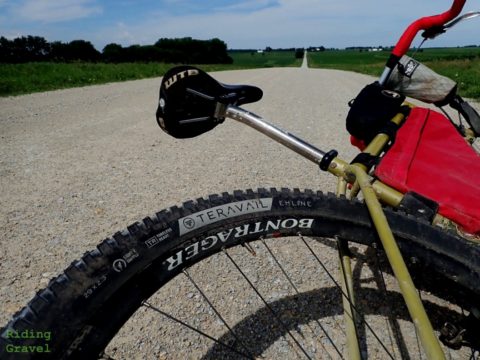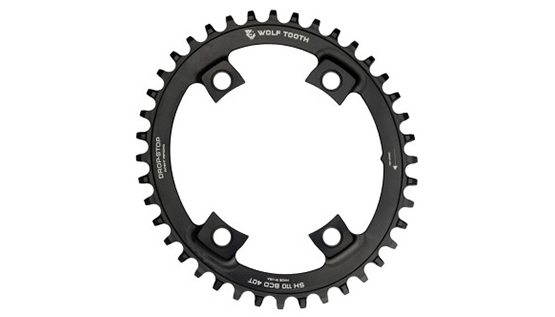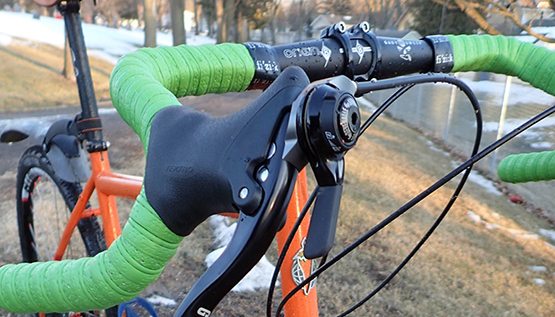<Back to News Home |
Suspension seatposts were a hot item in the late-1990s and early-2000s, particularly with mountain bike riders looking to add a bit of cush to their old hardtails. Unfortunately, those early designs reflected their first-generation status, and each had flaws that hindered its ultimate performance.

The earliest suspension posts were telescopic, with a form factor similar to today’s dropper posts. Unfortunately, from a bump absorption standpoint, telescopic posts were sub-optimal, as their down and forward travel wasn’t on the right plane to truly absorb bumps. That said, I used a number of different telescopic suspension seatposts on a number of xc racing bikes from 1995-2001 with good success. However; none were exactly what I’d call “durable” by modern standards, requiring frequent lubrication and bushing adjustments or replacement.
Early pivoting suspension posts tried to reduce the stiction and durability issues experienced in many telescopic posts. Unfortunately, the elastomer-based designs moved back and down as they cycle through their travel, so the effective reach to the bars changes. I own a short travel version of this type of post and have always wanted to love it, but its shortcomings (and the lack of refinement over the years) have prevented me from feeling the love.
Guitar Ted agreed, saying, “I’ve used the “short travel” version of this design in the past and while it is a useful component, there were several points I had issues with regarding the post’s performance and durability.”

I suspect the folks at Cirrus Cycles felt similarly as well, because while the BodyFloat design is similar to earlier designs in that it pivots on a parallelogram, that’s where the similarities end.
The links are oriented so the travel moves almost exclusively in a vertical plane, so while saddle height does vary as the post cycles through its travel, top tube length (and thus handling) does not. And the varying saddle height isn’t as noticeable as you might think before riding it. I’ll let you know if my impressions here change after riding the post more than 100 miles, but for now I’m stoked with how it feels on the bike.
Here are Guitar Ted’s first impressions on the performance of the BodyFloat on his Salsa Ti Mukluk:
For small to medium sized “chatter”, the post simply erases any inputs and prevents them from reaching your saddle. However; the post’s Achilles’ heel may be its undamped springs which, if you hit the right sort of bumps in succession, can bounce you in a way that can cause you to launch off the saddle. Admittedly, if you treat your bike like the hard tail that it is, (assuming you use the BodyFloat as recommended- on a hard tail bike), you probably will be getting out of the saddle for many of those sorts of situations.
The benefits of coil springs
Another big plus, particularly for cold weather cyclists, is the use of coil springs to suspend the BodyFloat. Not only do the coil springs provide a nearly stictionless, high-quality travel, they have absolutely no temperature sensitivity. The great feel I’m getting today (in 60-80 degree temps) should be exactly the feel I get on days when the thermometer touches zero. I like that. Other posts use elastomers or microcellular urethane bumpers to suspend the rider, and in more than 25 years of cycling, I’ve never ridden an elastomer that wasn’t at least somewhat temperature sensitive.

The other benefit of the dual coil spring setup on the BodyFloat is range and ease of adjustability. You can change out coil springs with stiffer or softer springs, and you can even run one firmer spring and one softer spring, making it easier to find exactly the right spring set for your weight. Then, you can dial in the ride you prefer with the preload adjuster. Cirrus Cycles offers an accessory no-tools adjuster knob for $20 that makes on-the-fly adjustment actually possible. That said, the stock 4mm Allen wrench adjuster is easy enough to use. You’ve just gotta stop and get a tool out to do it. Eazy peazy…
As you dial-in the preload, the saddle drops accordingly (as the parallelogram is compressing to preload the springs). So while preload reduces the negative travel (sag) of the post under the rider’s weight, it doesn’t significantly firm the travel at the bottom of the stroke. For that, it’s better to swap to a firmer spring (or two), I believe.

Guitar Ted and I spoke after our first 72 hours with our respective BodyFloat posts, and we agreed the setup was surprisingly easy. I don’t know what we expected, but neither of us expected to find exactly the ride we were looking for on our initial ride, but that’s how it’s worked out for us.
Here’s what Guitar Ted had to say about the post’s tunability:
The tune-ability is outstanding. One can dial in a preferred amount of “give” with any of several assorted coil springs, and this can be micro-adjusted on the fly with the new pre-load adjustment knob Cirrus Cycles has added with this latest incarnation of the BodyFloat post.
Of course we’re using that tunability, changing up springs and preload settings to see if we can improve on an already very good setup, and we’ll report our findings in a future report.
One of the first questions other cyclists ask after taking the BodyFloat for a test ride is “how much does it weigh?” In all honesty, in my haste to ride the post, I completely forgot to pop it onto the scale, so the weight will need to wait for now. That said, I have no reason to doubt Cirrus Cycles’ published weight for the post, which is 548 grams.
The BodyFloat line-up
While the 420mm Model 3.0 Ti post Guitar Ted and I are testing is both the most expensive (MSRP: $415) and heaviest post Cirrus Cycles manufactures, there are legitimate reasons for this being the case. The Ti post is the longest (by 40mm), strongest post they build, designed for those interested in ultimate strength and durability over light weight (think Tour Divide).
Those interested in lighter weight options will be more pleased the Model 3.0 post is also available with a carbon shaft in two lengths – 330mm (428g) and 380mm (465g). The carbon posts are also slightly less expensive, at $395. I tested the earlier Model 2.0 Carbon post in a 380mm length, and it was a great performing, durable post.
Cirrus Cycles also offers a much less expensive Model 2.0 alloy version of the BodyFloat, and at $225 and 493 grams, it’s clearly the value leader of the group.
Stay tuned to RidingGravel.com for updates on the performance and durability of the BodyFloat seatposts as Guitar Ted and I put our posts through their paces this fall and winter.
To learn more about BodyFloat suspension seatposts from Cirrus Cycles, head on over to CirrusCycles.com. Tell ’em RidingGravel.com sent ya’.
Discuss and share your questions or thoughts about gravel bikes, gear, events and anything else on the Riding Gravel Forum.
//











I have over 1000 miles on mine on a Niner RLT and really enjoy it. It has held up perfectly as well. Good product.